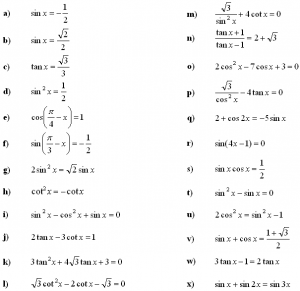

These describe the basic trig functions in terms of the tangent of half the angle. You can easily reconstruct these from the addition and double angle formulas. Tycho Brahe (1546–1601), among others, used this algorithm known as prosthaphaeresis.

You get the product xy! Three table look-ups, and computing a sum, a difference, and an average rather than one multiplication. If you want to multiply x times y, use a table to look up the angle α whose cosine is x and the angle β whose cosine is y. This group of identities allow you to change a sum or difference of sines or cosines into a product of sines and cosines.Īside: weirdly enough, these product identities were used before logarithms were invented in order to perform multiplication. They have some applications, but they’re usually narrow applications, and they could just as well be forgotten until needed. For example, if θ/2 is an acute angle, then the positive root would be used. The ones for sine and cosine take the positive or negative square root depending on the quadrant of the angle θ/2.

Sum, difference, and double angle formulas for tangent. Identities expressing trig functions in terms of their supplements. There’s also one for cotangents and cosecants, but as cotangents and cosecants are rarely needed, it’s unnecessary. The Pythagorean formula for tangents and secants. You can for example prove the angle sum and difference formulas with just a few lines. In fact, using complex number results to derive trigonometric identities is a quite powerful technique. They can all be derived from those above, but sometimes it takes a bit of work to do so. cos(2) cos2() sin2() sin(2) 2sin()cos() And with that, weve proved both the double angle identities for sin and cos at the same time. You should know that there are these identities, but they are not as important as those mentioned above. You only need to know one, but be able to derive the other two from the Pythagorean formula. Note that there are three forms for the double angle formula for cosine. Ptolemy’s identities, the sum and difference formulas for sine and cosine.ĭouble angle formulas for sine and cosine. Sine, tangent, cotangent, and cosecant are odd functions while cosine and secant are even functions. Sine, cosine, secant, and cosecant have period 2 π while tangent and cotangent have period π. Each of the six trig functions is equal to its co-function evaluated at the complementary angle. Identities expressing trig functions in terms of their complements. This is probably the most important trig identity. The Pythagorean formula for sines and cosines. But these you should.ĭefining relations for tangent, cotangent, secant, and cosecant in terms of sine and cosine. You don’t have to know all the identities off the top of your head. These identities mostly refer to one angle denoted θ, but there are some that involve two angles, and for those, the two angles are denoted α and β. It is convenient to have a summary of them for reference. You have seen quite a few trigonometric identities in the past few pages.


 0 kommentar(er)
0 kommentar(er)
